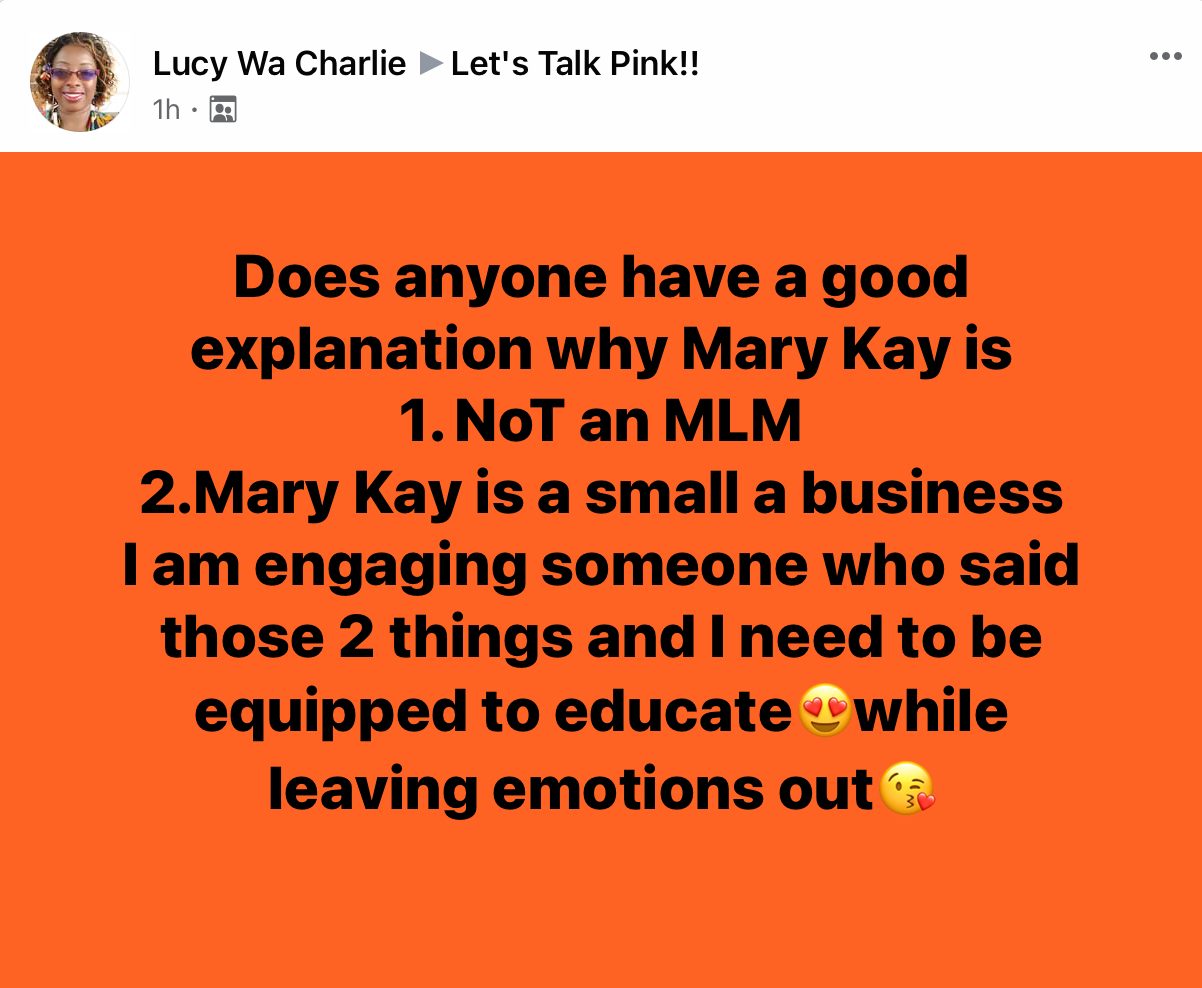
Ten Big Truths of MLM
 Almost ten years after Robert FitzPatrick wrote his 10 Big Lies of MLM, he wrote the flip side of it, the 10 Big Truths of MLM. Again, he is spot on with his analysis and nearly all of his points apply to Mary Kay too.
Almost ten years after Robert FitzPatrick wrote his 10 Big Lies of MLM, he wrote the flip side of it, the 10 Big Truths of MLM. Again, he is spot on with his analysis and nearly all of his points apply to Mary Kay too.
Mary Kay consultants and directors would have you believe MK is “different,” but it’s really not. They say it’s not multi-level, it’s dual level. They say it’s not MLM, it’s direct sales. It’s not recruiting, it’s sharing. The products really are sold! Think like a retailer. Don’t order to meet a goal (except when you fall short of that goal and don’t want to start over next month).
- Multi-level marketing has little or nothing to do with “direct selling.”
- Multi-level marketing’s structure is based on an audacious and obvious impossibility.
- Almost no one — far less than one in a hundred — has ever gained any net profit in multi-level marketing.
- Most, nearly all, product purchases by MLM participants are driven by MLM rules, purchase requirements and reward-promises.
- MLMs are dependent on constantly recruiting new people to replace all those that quit.
- “Multi-level marketing” is undefined and its identity is a fiction.
- MLM is unregulated; according to the FTC, there is no way for a consumer to know if an MLM is a fraud.
- Multi-level marketing stresses, harms and sometimes destroys social and professional relationships, families and marriages.
- The characteristics of “multi-level marketing” are the defining characteristics of a pyramid scheme.
- Multi-level marketing employs cult persuasion techniques to deceive and control.
Again, the piece is long, but a worthwhile read to really dig into why MLMs are scams and not real business opportunities.
In the case of “multi-level marketing,” it is not absence of information about pyramid schemes, endless chains, direct selling and financial fraud or any previous beliefs that have enabled the myth of MLM as “direct selling” and the “greatest income opportunity in the world” to develop and endure. The truth about multi-level marketing is in plain sight and has been known since MLM first emerged. The truths are supported by common sense, mathematics, and historically-verified, data-supported and directly-experienced facts that are easily found.
In MLM, myth has prevailed over reality due to the active propagation of fabricated claims and deliberate lies, a massive campaign of dis-information, concealment, contrived statistics and phony testimonials aimed at obscuring, hiding or denying facts of how it actually works, where the money comes from and the scale of losses it causes. The MLM myth is a classic example of the Big Lie phenomenon, a false assertion so outrageous and blatant in its deceptiveness that ordinary people can hardly even imagine it to be deliberately fabricated. The Big Lie is now understood as a classic technique of propaganda used both commercially and politically. It is based on the premise: People will believe a big lie sooner than a little one; and if you repeat it frequently enough people will sooner or later believe it.
Other “rules” associated with the Big Lie are regularly applied in promoting the myth of MLM as a legitimate business opportunity, such as never admit a fault or wrong… never leave room for alternatives; never accept blame… blame (others) for everything that goes wrong. The power of the Big Lie includes not only imposing beliefs but also subverting and inhibiting faculties and voices of reason and experience that contradict them. It follows, then, that MLMs operate as authoritarian, thought-controlling organizations in order to perpetrate the Big Lie about “income opportunity” and “direct selling.” This includes large-scale lobbying and corruption of governments to prevent investigation and law enforcement.
MLMs are often called “blame-the-victim” frauds for their universal practice of assigning “blame” for the inevitable financial losses to the victims themselves. The practice is summed up in the classic MLM aphorism, Only Quitters lose and only Losers quit. Virtually all MLM participants do inevitably quit, most within one year. Yet, due to techniques of the Big Lie employed by MLM promoters – including the absence of law enforcement – most MLM victims remain silent, enmeshed in confusion and shame or fear of retribution or possible incrimination. Many take on the shameful status, assigned by the MLM of “loser,” which can afflict them for years.
Truth #1: Multi-level marketing has little or nothing to do with “direct selling.”
Virtually no MLM participants gain a net profit from personal, direct selling on a retail basis. There is no record of consumers gaining a sustainable profit just from reselling MLM products in the open market. The FTC verified this reality in Herbalife when it conducted a two-year investigation of that MLM, one of the oldest and largest. It determined that Herbalife “distributors” did not and could not gain a “retail profit” income. The only possible income came from recruiting more investor- participants.
Common sense alone reveals that no one, today, could earn a sustainable income selling MLM commodity products on their own, from their home. MLM-type products are already in stores or online at lower prices. No one needs a personal salesperson to buy such goods or has the time to listen to sales pitches. The costs of personal marketing and individual selling are too high to gain a profit or make it worth the time. The MLM model produces more and more competitive “retailers” in every location and every potential retail customer is offered the chance to buy at wholesales, making retail selling not feasible.
MLM is disguised to look like direct selling, with the use of products and words and names taken from the real business of direct selling, such as “commissions, bonuses, retail, and distributor.” This is only disguise. The “direct sellers” in MLM have few or no customers. “Downlines” are just other “direct sellers.” MLM participants don’t “sell.” They buy and recruit others to do the same.
Truth #2: Multi-level marketing’s structure is based on an audacious and obvious impossibility.
The main fraud of multi-level marketing is in plain sight. It is the model of the “endless chain” of recruits, misnamed as “salespeople, associates, distributors, coaches”, etc. How could any sales organization have an “unlimited” number of sellers operating in the same areas? How could a sales chain extend to “infinity?”
The MLM model actually is two-lies-in-one. First, obviously, as the number of participants increases, the chance to recruit a large downline diminishes for those at the end of the chain. The “opportunity” is not “unlimited.” It is finite and diminishing. The thousands at the bottom of the pyramid cannot possibly enroll as many recruits as those few at the top already have. Saturation prevents virtually all from finding enough new people.
Second, saturation aside, the recruiting chain pay-plan requires each participant to enroll a number of recruits before profit is possible. Therefore, a ratio of “winners” to “losers” is baked in right from the start. If 25 are needed, then only one in 25 could ever be profitable. This would be true the day the scheme is launched and would never change. The “income opportunity” is therefore — by design — limited to one in 25, or 4%. Based on the proposition of gaining profit from recruiting, 96% would always lose for as long as the scheme operated. In practice, the actual ratio is far worse.
Truth #3: Almost no one — far less than one in a hundred — has ever gained any net profit in multi-level marketing.
Of all the people who have ever paid an MLM sign-up fee, signed an MLM “sales” contract, and hoped to make some money — millions and millions of people — the percentage that ever succeeded is too small to graphically illustrate. This reality of the absence of “income opportunity” sold as “the best income opportunity in the world” is perhaps the biggest deception that has been sown.
Millions of people have been misled to believe that MLM is a viable investment, maybe their best hope
to make money, better than their current job, superior to other businesses, more lucrative than the potential from higher education or the corporate ladder or even professions. The contrary and brutal reality — that it is a swindle — is verified in all MLM “income disclosures” when they are deciphered, and it is revealed every time an MLM is prosecuted.
The most shocking figure is the percentage of people who made a profit, among the total that ever joined the MLM scheme since it began. Since MLMs churn 50-80% of recruits every year, new recruits should calculate their odds of success with all that ever joined. That calculation shows the percentage of “winners” to be a micropercentage of one percent, effectively, no chance at all.
All statements or claims about “average incomes” in multi-level marketing are, therefore, false on
their face. There is no income “on average.” The median (half make more and half less) is Zero (it
would be a negative figure if costs were factored). MLM promoters spread contrived statistics about income averages — restricting data to a one-year or even one-month time frame, and limiting data only to a small portion of the total participants, sometimes called “actives” or “active with a downline” or those who “received a check.” They often combine the incomes of the few top recruiters with a selected, limited group, excluding the majority, to produce a false “average.”
Truth #4: Most, nearly all, product purchases by MLM participants are driven by MLM rules, purchase requirements and reward-promises.
Without the connection of promises-of-rewards to purchasing-of-products and without purchase-quotas and purchasing-requirements few people would ever buy MLM products. The products, typically, are higher priced than similar products in stores. Without the pot-of-gold “incentives,” many people would simply never buy MLM products at all because they never heard of them or never wanted or needed them in the first place. Most MLM participants begin to purchase MLM products only after being solicited to join the “business opportunity” and signing a lengthy and restrictive commercial contract that redefines them as “independent distributors.” In signing, they relinquish normal consumer rights
such as easy return of products, freedom to criticize or do what they want with the product or resell it as they wish.
After signing up, to become or to remain qualified for promised rewards tied to recruiting MLM participants must then meet volume quotas that can be fulfilled, partly or fully, by making personal purchases every month. Many MLMs persuade participants when they sign up to commit to automatic monthly purchases on their credit cards to ensure continued “qualification.” Failure to make the quotas results in loss of status or disqualification for promised rewards. Overall, most MLM participants stop buying MLM products within one year or less and never purchase them ever again.
Truth #5: MLMs are dependent on constantly recruiting new people to replace all those that quit.
Most MLM participants quit within one year. Almost all gain no net profit, and lose time and money from the scheme. Annual quitting rates among MLM participants are between 50% and 90%. If the MLM does not replace the quitters, it will soon collapse. To continue, MLMs keep expanding to new areas, concealing the quitting and loss rates, and aggressively promote the false claim that the schemes offer a “unique” and “extraordinary” income opportunity for all. As MLMs expand to new areas, revenue “pops,” and as the inevitable losses occur, revenue “drops,” triggering the need for more geographic expansion or the targeting of new groups.
There is no stable or sustainable “sales force” and no stable or sustainable “customer base.” There is only constant recruiting based on a false income promise. MLMs are in a constant state of continual collapse, but the cost of the collapse is borne only by the newest recruits who join the scam, lose their money and then quit: meanwhile the scheme itself can continue operating if enough replacement-recruits are found.
Truth #6: “Multi-level marketing” is undefined and its identity is a fiction.
The US government defines “legitimate multi-level marketing” as a type of enterprise in which participants can earn money from their own retail sales and from commission overrides based on the retail sales of other participants they recruit in a genealogical chain. Yet, the FTC has never identified a single MLM company that meets this definition!
Since no one in MLM actually does gain or could gain sustainable profit from retailing, (see Truth #1), no one also gains income from retail sales of those recruited. The legitimate, retail-based MLM is as real as a Unicorn.
Unicorns are depicted in art and literature and some people may even believe they exist. In reality, retail-based MLM enterprises, like Unicorns, do not exist. The very term, “multi-level marketing” means nothing. MLMs are not “multi-level.” They have “endless” levels. MLMs do not operate in the “market” but within a closed and controlled network with fixed prices and purchasing induced by promises of financial reward, unrelated to the products and consumer market factors.
Truth #7: MLM is unregulated; according to the FTC, there is no way for a consumer to know if an MLM is a fraud.
Consumers are on their own for evaluating MLM solicitations and avoiding pyramid fraud by MLMs. There is no “consumer protection” from deception and harm at the hands of MLM recruiters. MLMs operate without regulation. There is no federal law that includes the terms, “multi-level marketing” or “pyramid scheme.” The Federal Trade Commission (FTC) has become the primary law enforcement agency that prosecutes MLMs as “pyramid schemes” but the FTC has never conducted a survey of the “industry” to see whether fraud is predominant. In the past 35 years, FTC has prosecuted less than 30 MLMs for pyramid fraud; all have been small MLM companies. The FTC advises consumers that “MLM is legitimate” but also warns that “some” MLMs are pyramid frauds. Yet, the FTC also states that it is unlikely ordinary consumers can distinguish what it defines as “legitimate MLM” from a pyramid fraud, claiming it would require “complex economic analysis.”
Meanwhile, there is not even an FTC requirement for MLMs to make financial disclosures in solicitations, as there is for franchising, which is a legitimate and sustainable business model. The FTC actually exempts MLMs from disclosing any financial information at all — e.g., loss rates, average incomes, saturation, operating costs, etc., — to consumers when they solicit money.
Even when MLMs are prosecuted as pyramid schemes, the offense is treated only as “unfair and deceptive business practice,” not criminal fraud, even though thousands of people are harmed and consumer losses may involve billions of dollars. By defining a “pyramid scheme” as only a civil offense or at most a misdemeanor, some “anti-pyramid scheme” state statutes and occasional FTC prosecutions effectively protect MLMs and shield MLM leaders from doing jail time while also allowing deceptive schemes to continue and multiply.
Truth #8: Multi-level marketing stresses, harms and sometimes destroys social and professional relationships, families and marriages.
By violating the common-sense, practical and proven custom to keep personal and business relationships separate, MLMs cause disruption and harm. Since the MLM “business opportunity” inevitably results in financial losses for nearly all and requires deception, recruiting friends and family into MLMs obviously creates mistrust and resentment. When trust, affection, family ties and professional connections are misused for MLM recruiting, relationships are weakened or even ruined. The results are frequent disputes, divorces, alienation and blame.
Those that become immersed in MLM deception will often try to manipulate and deceive the people closest to them for recruiting purposes, often destroying those nurturing relationships. When the MLM recruiters later quit the schemes themselves, they often discover they have lost the support of their family, close friends and social network. Some people remain trapped in MLM because they have harmed or neglected their life-long connections.
Truth #9: The characteristics of “multi-level marketing” are the defining characteristics of a pyramid scheme.
A pyramid scheme is a fraud in which a financial investment is solicited based on a promise of profit that will be derived primarily from the new participants who are solicited by earlier participants. Unless new participant-investors are successfully recruited, there is no feasible profit. A pyramid scheme is inherently deceptive and is illegal because the promised rewards cannot continue to be fulfilled. The continued expansion that the promise requires cannot occur. The majority of all who invest must lose. Solicitations are therefore inherently deceptive and pyramid schemes always cause financial harm.
The defining elements of MLM perfectly match this description. These include:
- An impossible “endless chain” structure, with no limit based on geography or market size, creating the false promise of “unlimited” income opportunity for all participants based on the illusion of perpetual expansion capacity.
- A requirement to make a payment (financial investment, also called “pay-to-play”) to join the recruiting chain, usually in the forms of entry fees, product purchases and related costs (start up “sales” kits, monthly purchase quotas, fees for websites, “back office,” leads, seminars, etc.)
- The effective requirement to recruit other investor-participants in order to gain the promised rewards. The claim that income can be gained from retail sales is only a sham invented for the purpose of disguising the recruiting scheme as “direct selling.” (see Truth #1). Net profit is available only to a few and only from recruiting.
- A closed, money transfer in which rewards come primarily from the investments of newly recruited participants, not from the external open market, based on retail sales. The “reward” payments are merely the recruits’ own money moved from later recruits to earlier ones inside a closed network, unrelated to the true marketplace. Making the losses even greater and harming even more people, MLM pay-formulas (“compensation” plans) – as all pyramid schemes do – transfer most of all the money gained from later investor-participants directly to the earliest promoters situated at the very top of the pyramid. At least half of all “commissions” paid out to all levels of the entire chain are transferred directly to 1-4% of participants positioned at the top of the pyramid each year.
Truth #10: Multi-level marketing employs cult persuasion techniques to deceive and control.
All cults promise some kind of utopia or unique status to followers, and they
also create fear among the followers that failure to follow the cult’s program and to remain in the cult will result in terrible consequences. Cults use well-known methods to shut down critical judgment and induce self-destructive and irrational actions from large numbers of people. MLMs qualify as cultic due to their claim, unique in the business world, to be able to expand to “infinity” and to have the power to provide “unlimited” income to all that follow the program. MLMs promote “financial success” and “wealth beyond imagination” as a form of heaven-on-earth. MLM leaders claim to have esoteric knowledge of the “secrets” of success. The cultic tools of mind control used by MLMs and the hallmark characteristics of cults exhibited by MLMs include:
- Deception
- Self-anointed god-like leadership –
- Manipulation
- Sudden and significant changes of personality and behavior among followers
- Pseudo-science or pseudo-economics
- Control of information
- False or fearsome justification
- Extreme Structural complexity
- Authoritarian control





 Visit the
Visit the
There is so much great stuff in this essay, I think I will need to read it a few more times to digest it all. Consider this page bookmarked.
Most of what’s here I already understood, but the “Big Lie” aspect was one I hadn’t previously considered. Yes, Mr. FitzPatrick is right: people will believe a big lie before they’ll swallow a little one. The Earth is flat; the Moon landings were faked; Elvis is still alive; aliens built the pyramids…plenty get taken in by silly lies, and cling to them against all reason.
A whopper bandied about by MLM apologists is that market saturation is “impossible” because the human population is “not finite.” Since new people are reaching adulthood every day, there are always new customers, so how can there be saturation? This little chestnut, found in “Multilayer Marketing for Dummies” (an apt title), has two patently false assumptions: 1) population isn’t finite; 2) as long as one customer is left unreached, the market isn’t saturated.
1) Population IS finite: any number that can be expressed as an integer is finite.
2) Market saturation means there are too few customers to sustain a business, not that there are zero customers. Population growth alone cannot sustain a new business.
But the Biggest Lie Of All is that MLMs cannot be pyramid schemes because they (pretend to) sell products. That one gets parroted a LOT.